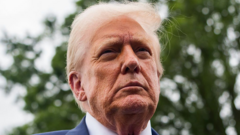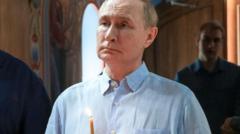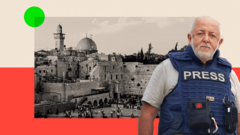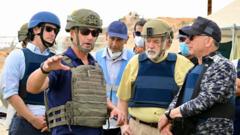As tensions between Israel and Iran reach unprecedented levels following a series of military strikes, the true intentions behind Israel's operations remain a focal point of international scrutiny. Prime Minister Benjamin Netanyahu’s recent overtures urging Iranians to rise against their government offers a glimpse into Israel's strategy to potentially alter the balance of power in the Middle East.
**Unraveling Israel's Military Strategy Against Iran: A Quest for Freedom or Annihilation?**
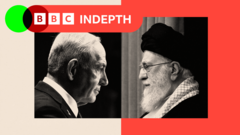
**Unraveling Israel's Military Strategy Against Iran: A Quest for Freedom or Annihilation?**
In light of escalating military actions against Iran, analysts explore Israel's motivations, effects on regional dynamics, and implications for future negotiations.
Following a dramatic missile strike that targeted key Iranian sites including Tehran's military facilities, Netanyahu launched appeals directly to the Iranian populace, claiming that Israel’s military campaign was aimed at dismantling the "evil and oppressive regime" ruling Iran. Analysts are now delving into the multifaceted objectives behind these bold military moves, questioning whether Israel is merely focusing on diminishing Iran's nuclear capabilities or if it harbors broader ambitions, such as regime change in Tehran.
For decades, Netanyahu has positioned Iran as the primary threat to Israel's security; however, some observers suggest that his current approach could also serve to disrupt any ongoing diplomatic negotiations concerning Iran’s nuclear program. The timing of the strikes raises suspicions that they could have been strategically planned to undermine the potential for an agreement between the U.S. and Iran, which may have been reaching a pivotal point.
The onslaught is not without its controversies, as many nations and legal experts criticize the legality of targeting nuclear sites. The International Atomic Energy Agency (IAEA) has voiced its opposition, emphasizing the need for the integrity of nuclear facilities regardless of the political climate. Iran, on its part, maintains that its nuclear ambitions are purely for peaceful purposes, despite mounting evidence indicating its stockpiling capability.
Amidst the chaos of escalating attacks and counterattacks, the civilian population bears the brunt of the violence. The complex geopolitical landscape and the historical grievances between these two nations raise concerns about the potential for a wider regional conflict. With both sides responding to each attack with military retaliation, the situation continues to spiral into a precarious stalemate, further complicating diplomatic efforts led by the United States.
On the Iranian side, public sentiment is tougher to decipher. Years of international sanctions have embittered the populace, but it's unclear whether they could rally behind a foreign military strike aimed against their nation. Analysts suggest that while initial military successes might have stoked a sense of reprieve from oppressive leadership, ongoing bombardments on civilian infrastructure could tilt public opinion back toward nationalistic sentiments.
Israel's intent appears twofold: to cripple Iran’s nuclear aspirations while also inciting fear among its clerical leadership through a show of military force. Statements from Netanyahu hint at a vision of a future devoid of the Iranian regime, but the realities on the ground will ultimately determine the outcome of this perilous endeavor.
The complex interplay of regional politics, military aggression, and potential diplomatic negotiations suggest that the conclusion of this confrontation is intricately tied to U.S. intervention and the strategies adopted by its leaders. As the situation unfolds, the world watches closely, awaiting a resolution that may dictate the course of Middle Eastern politics for years to come.
For decades, Netanyahu has positioned Iran as the primary threat to Israel's security; however, some observers suggest that his current approach could also serve to disrupt any ongoing diplomatic negotiations concerning Iran’s nuclear program. The timing of the strikes raises suspicions that they could have been strategically planned to undermine the potential for an agreement between the U.S. and Iran, which may have been reaching a pivotal point.
The onslaught is not without its controversies, as many nations and legal experts criticize the legality of targeting nuclear sites. The International Atomic Energy Agency (IAEA) has voiced its opposition, emphasizing the need for the integrity of nuclear facilities regardless of the political climate. Iran, on its part, maintains that its nuclear ambitions are purely for peaceful purposes, despite mounting evidence indicating its stockpiling capability.
Amidst the chaos of escalating attacks and counterattacks, the civilian population bears the brunt of the violence. The complex geopolitical landscape and the historical grievances between these two nations raise concerns about the potential for a wider regional conflict. With both sides responding to each attack with military retaliation, the situation continues to spiral into a precarious stalemate, further complicating diplomatic efforts led by the United States.
On the Iranian side, public sentiment is tougher to decipher. Years of international sanctions have embittered the populace, but it's unclear whether they could rally behind a foreign military strike aimed against their nation. Analysts suggest that while initial military successes might have stoked a sense of reprieve from oppressive leadership, ongoing bombardments on civilian infrastructure could tilt public opinion back toward nationalistic sentiments.
Israel's intent appears twofold: to cripple Iran’s nuclear aspirations while also inciting fear among its clerical leadership through a show of military force. Statements from Netanyahu hint at a vision of a future devoid of the Iranian regime, but the realities on the ground will ultimately determine the outcome of this perilous endeavor.
The complex interplay of regional politics, military aggression, and potential diplomatic negotiations suggest that the conclusion of this confrontation is intricately tied to U.S. intervention and the strategies adopted by its leaders. As the situation unfolds, the world watches closely, awaiting a resolution that may dictate the course of Middle Eastern politics for years to come.





